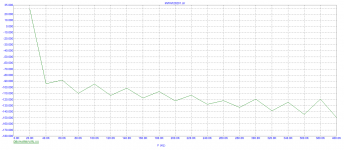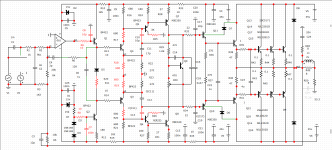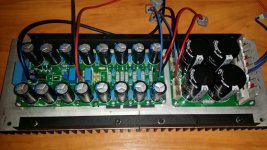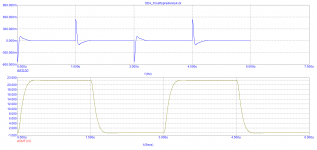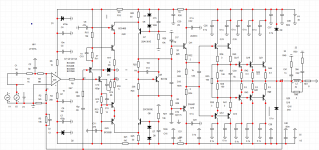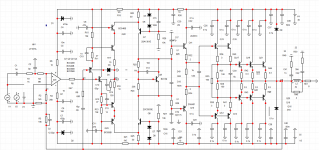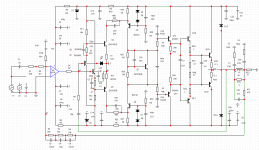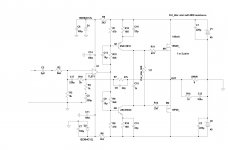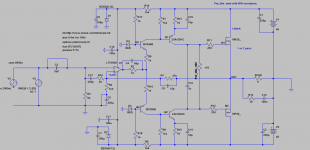Microcap draws a little differently,but I'll try to show a similar picture
Attachments
Last edited:
This graph has less details compared to ltspice's graph, but
generally speaking it's very similar to what I posted...
generally speaking it's very similar to what I posted...
Impressive thread! I try to follow / understand, but there were so many versions I am not sure which one is the one to build. So may I ask which one sounds best? I would prefer a discrete version without opamps, and also I tend to like BJT quasi output stages, but if latfets or hexfets sound even better I would be tempted too!
>Impressive thread! I try to follow / understand, but there were so many versions I am not sure which one is the one to build.
>So may I ask which one sounds best?
As I wrote in one of the previous messages:
> I'll give $100 to anyone who will distinguish any of these amps in blind listening test
So that's for "which amp sounds the best" question.
From the 3 amps I built in this thread: Lomakin & Parshin BJT, Wiederhold77 Latfet, and Wiederhold77 Quasi HexFet - if I was to build another one I would do Wiederhold77 Latfet.
Simple to build, and theoretically should be sounding the best (disputable opinion).
Lomakin in Parshin is also simple and smaller - I built it with 1 pair of output devices.
For me the next possible candidates to build are:
1) post #792 (Philips 22AH578)
2) post #850
3) Maxim's LMK version, given it's fast(er) and stable(r)
Unfortunately(?), they all have op-amps in the front.
I think this gives the best results, if someone wants to build good quality amp.
That's kind of the theme of this thread. I was specifically looking for amps with op-amps as the input.
>So may I ask which one sounds best?
As I wrote in one of the previous messages:
> I'll give $100 to anyone who will distinguish any of these amps in blind listening test
So that's for "which amp sounds the best" question.
From the 3 amps I built in this thread: Lomakin & Parshin BJT, Wiederhold77 Latfet, and Wiederhold77 Quasi HexFet - if I was to build another one I would do Wiederhold77 Latfet.
Simple to build, and theoretically should be sounding the best (disputable opinion).
Lomakin in Parshin is also simple and smaller - I built it with 1 pair of output devices.
For me the next possible candidates to build are:
1) post #792 (Philips 22AH578)
2) post #850
3) Maxim's LMK version, given it's fast(er) and stable(r)
Unfortunately(?), they all have op-amps in the front.
I think this gives the best results, if someone wants to build good quality amp.
That's kind of the theme of this thread. I was specifically looking for amps with op-amps as the input.
Circuits with a very large loop gain. The presence of an oscilloscope will help in the construction, although an experienced colleague can cope without it .
I can show you a symmetrical amplifier circuit . Slightly different topology.
I can show you a symmetrical amplifier circuit . Slightly different topology.
Last edited:
Maxim, I'm referring to your amp from post #595, this seems to be the "latest and greatest" from you.
As for asymmetrical design, this one gives so far the best overall results, except:
1) high amplitude (50Vpp) square waves have ugly kinks, and need further improvements
2) making these squares better, will slow down the amp, to basically the same speed as standard LMK/Wiederhold.
15V/us seems enough for any normal amp, but I would like to try something faster. No point to build the same thing again and again 🙂
3) This amp will be tricky to build in practical terms: all of these devices affect stability, and the margin of stability, even in the sim, is thin: C6, C7, C10, R6, L2, C17, C18 - in real build this will be a nightmare.
Do you think a better version of this design is possible?
Symmetrical? Simpler?
As for asymmetrical design, this one gives so far the best overall results, except:
1) high amplitude (50Vpp) square waves have ugly kinks, and need further improvements
2) making these squares better, will slow down the amp, to basically the same speed as standard LMK/Wiederhold.
15V/us seems enough for any normal amp, but I would like to try something faster. No point to build the same thing again and again 🙂
3) This amp will be tricky to build in practical terms: all of these devices affect stability, and the margin of stability, even in the sim, is thin: C6, C7, C10, R6, L2, C17, C18 - in real build this will be a nightmare.
Do you think a better version of this design is possible?
Symmetrical? Simpler?
Here is a simple circuit with a gain of 94 dB at 20 kHz. Distortion is also minimal.
The slew rate has been increased . .
The slew rate has been increased . .
Attachments
Last edited:
This is traditional (EF) VAS, not folded cascode...
That's something else, but perhaps worth trying. Nothing wrong with EF VAS, actually this might be the best one 🙂
That's something else, but perhaps worth trying. Nothing wrong with EF VAS, actually this might be the best one 🙂
Last edited:
Понял.
On my forum all this is in the public domain
On my forum all this is in the public domain
Attachments
Last edited:
What is that last transistor on the right side?
DC detect and protection? Overcurrent protection?
DC detect and protection? Overcurrent protection?
Overload protection based on thyristor analog .
Without protection
Without protection
Attachments
Last edited:
Last edited:
The simple version that started it all.
Resistors in the opamp power supply circuit eliminate the disadvantages of incomplete spice models
Resistors in the opamp power supply circuit eliminate the disadvantages of incomplete spice models
Attachments
Last edited:
If we decide to use normal VAS - not a folded cascode like LMK or Wiederhold, here is a simple amp based on Crest topology.
Gives great results, SR approx 60V/us,
very good square waves, and frequency profile.
For such simple amp - great results..
FFT/Thd screenshots at 10kHz.
Gives great results, SR approx 60V/us,
very good square waves, and frequency profile.
For such simple amp - great results..
FFT/Thd screenshots at 10kHz.
Attachments
If you reduce the loop gain, the slew rate can actually be increased. But here it is not clear what is more important ? Speed or distortion spectrum? Note That the LMC / LP has built-in anti-overload correction, which reduces the requirements for the slew rate. offtop. in the latter case, the speed is more than 60 v / MS when changing the scheme of nested OOS.However, the loop gain is reduced
This one - same VAS, but extra buffer added between op-amp and VAS is even better.
Lower Thd, beter FFT, faster Slew Rate (60V/us), very stable, and easy to compensate.
This is also based on Crest amp.
Kind of similar to the Philips amp I was testing few pages ago, but with different (better) VAS compensation,
Lower Thd, beter FFT, faster Slew Rate (60V/us), very stable, and easy to compensate.
This is also based on Crest amp.
Kind of similar to the Philips amp I was testing few pages ago, but with different (better) VAS compensation,
Attachments
Last edited:
- Home
- Amplifiers
- Solid State
- Unusual amp from 1987
